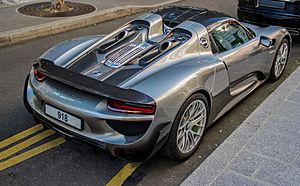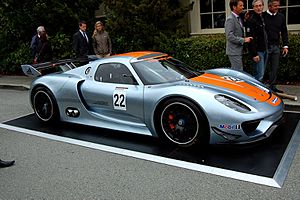Porsche 918 Spyder facts for kids
Quick facts for kids Porsche 918 Spyder |
|
|---|---|
 |
|
| Overview | |
| Manufacturer | Porsche AG |
| Production | September 2013–June 2015 918 units |
| Model years | 2013–2015 |
| Assembly | Germany: Stuttgart, Zuffenhausen |
| Designer | Michael Mauer, Hakan Saracoglu |
| Body and chassis | |
| Class | Sports car (S) |
| Body style |
|
| Layout | Mid-engine, all-wheel-drive |
| Doors | Conventional (918 Spyder) Butterfly (918 RSR concept) |
| Powertrain | |
| Engine | 4,593 cc (4.6 L) Porsche M18.00 V8 |
| Electric motor | 2 electric motors on front and rear axle |
| Power output | 887 PS (652 kW; 887 PS; 875 hp) |
| Transmission | 7-speed PDK dual-clutch |
| Hybrid drivetrain | PHEV |
| Battery | 6.8 kWh liquid-cooled lithium-ion battery |
| Range | 680 km (420 mi) (EPA) |
| Electric range | 19 km (12 mi) (EPA) |
| Dimensions | |
| Wheelbase | 2,730 mm (107.5 in) |
| Length | 4,643 mm (182.8 in) |
| Width | 1,940 mm (76.4 in) |
| Height | 1,167 mm (45.9 in) |
| Curb weight | 1,634–1,720 kg (3,602–3,791 lb) |
| Chronology | |
| Predecessor | Porsche Carrera GT |
| Successor | Porsche Mission X |
The Porsche 918 Spyder is an amazing sports car made by the German company Porsche. It's a special type of car called a plug-in hybrid. This means it uses both a powerful gasoline engine and electric motors. The engine is a big V8, and with the two electric motors, it creates a huge amount of power!
The 918 Spyder has a special battery that lets it drive on electricity alone for about 12 miles (19 km). Porsche started making this car on September 18, 2013. It was a very expensive car, costing around €781,000 (about US$845,000). All 918 cars were sold out by December 2014, and production stopped in June 2015.
The idea for the 918 Spyder was first shown as a concept car at the Geneva Motor Show in March 2010. People loved it so much that Porsche decided to build it. The final production version was shown at the Frankfurt Motor Show in September 2013. Porsche also showed a racing version called the 918 RSR, but it was never actually produced. The 918 Spyder was the second plug-in hybrid car Porsche ever made.
Contents
How the Porsche 918 Spyder Works
The 918 Spyder gets its power from a 4.6-liter V8 gasoline engine. This engine is similar to the one used in Porsche's RS Spyder race car. It's very powerful, making 447 kilowatts (about 600 horsepower) on its own.
But that's not all! The car also has two electric motors. One electric motor helps power the rear wheels along with the gasoline engine. The other electric motor powers the front wheels. Together, the engine and electric motors create an incredible 887 horsepower! This allows the car to go from 0 to 60 mph (0 to 100 km/h) in just 2.6 seconds. It can reach a top speed of 345 km/h (214 mph).
Independent tests showed it could go even faster! It reached 60 mph in 2.2 seconds and had a top speed of 351.5 km/h (218.4 mph). This makes it one of the fastest production cars ever made.
Battery and Charging
The 918 Spyder stores its energy in a 6.8 kWh lithium-ion battery pack. This battery is located behind the passenger seats. You can charge the battery by plugging the car in, just like a phone. It also charges itself when the car brakes (called regenerative braking) or when the gasoline engine has extra power.
Charging the battery at home takes about seven hours with a regular outlet. With a faster charger, it takes about two hours. If you find a special DC charging station, the battery can be fully charged in just 25 minutes!
Driving Modes
The 918 Spyder has five different ways it can be driven:
- E-Drive: In this mode, the car runs only on battery power. It can go up to 93 mph (150 km/h) and travel about 12 miles (19 km) on electricity alone.
- Hybrid and Race Modes: These modes use both the gasoline engine and the electric motors. They balance fuel economy and performance.
- Hot Lap: In Race mode, there's a special "push-to-pass" button. This gives the car an extra boost of electrical power for super-fast laps.
The car's main body is made from a very strong and light material called carbon fiber. This helps make the car both safe and incredibly fast.
Production and Sales
The Porsche 918 Spyder was made in a limited number, only 918 units in total. It was built in Germany, with development in Weissach and assembly in Zuffenhausen. Production started in September 2013, and the first cars were delivered in December 2013.
The United States bought the most 918 Spyder cars, with 297 units. China and Germany each bought about 100 cars, and Canada bought 35. Production of this special car ended in June 2015, as planned.
Weissach Package
Porsche offered a special option for the 918 Spyder called the Weissach Package. It cost an extra $84,000! This package was designed to make the car even lighter and more aerodynamic (better at cutting through the air).
The Weissach Package included special lightweight wheels made of magnesium. Many parts of the car, like the roof, mirrors, and even parts of the inside, were made from carbon fiber. This helped to reduce the car's weight, making it even faster.
Porsche 918 RSR Racing Car
At the 2011 North American International Auto Show, Porsche showed a racing version of the 918 Spyder called the 918 RSR. This car used a different kind of hybrid system. Instead of a plug-in battery, it used a special flywheel system to store energy, similar to what's used in some race cars.
The RSR's V8 engine was even more powerful than the Spyder's, making 414 kW (about 555 horsepower). The electric motors added another 150 kW (about 200 horsepower) each, for a total of 564 kW (about 756 horsepower). This racing car was designed for extreme speed on the track.
Nürburgring Lap Record
In September 2013, a Porsche 918 Spyder with the Weissach Package set an amazing record at the famous Nürburgring race track in Germany. It completed the 12.8-mile (20.6 km) course in just 6 minutes and 57 seconds! This made it the first street-legal production car to ever finish the track in under 7 minutes. It was a huge achievement for Porsche and the 918 Spyder.
Gallery
See also
 In Spanish: Porsche 918 para niños
In Spanish: Porsche 918 para niños
- List of production cars by power output
- Government incentives for plug-in electric vehicles
- List of modern production plug-in electric vehicles














